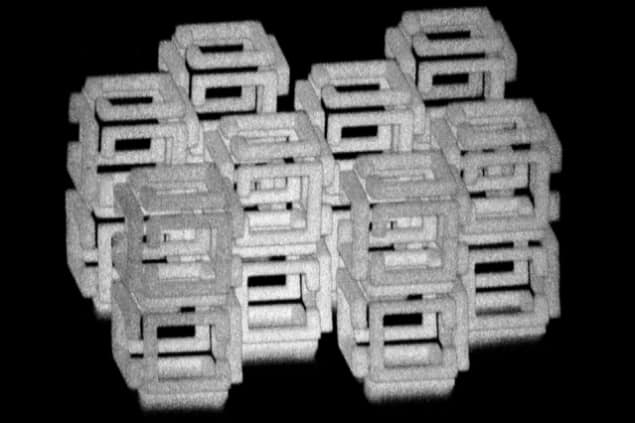Imploding hydrogel shrinks objects to the nanoscale
14 Dec 2018 Belle Dumé
A new 3D nanofabrication technique called Implosion Fabrication could be used to create a wide variety of nano- and microstructures not previously possible. The technique, which can print 3D objects of nearly any shape by patterning a polymer scaffold with a laser and then shrinking the structure to a thousandth of its original volume, might be used to make novel optical metamaterials and electronics devices.
Shrinking hydrogel scaffold
Most existing nanofabrication techniques are limited in what they can produce. Direct laser writing methods, for example, can produce 2D patterns but not 3D ones, which need to be built up a layer at a time – a process that is difficult and slow. Lithography, one of the oldest nanofabrication techniques, can again only print 2D layers on patterned surfaces.
Researchers led by Edward Boyden of the Massachusetts Institute of Technology have now put forward a new technique in which they use a laser to create patterns of reactive chemical groups inside a hydrogel scaffold. They then deposit material (which can be anything from quantum dots, a piece of DNA or gold nanoparticles) into the reactive groups in 3D. Finally, they dehydrate the gel (using an acid), which implodes the scaffold and the printed object it contains to a thousandth its original volume and form a nanoscale structure.
The researchers showed that their ImpFab technique works by printing highly conducting 3D nanostructures in silver that keep their complex array shape after shrinkage.
Almost any shape is possible
“As mentioned, most lithography techniques in use today are limited to 2D and while direct laser writing can fabricate 3D objects, these must be connected and self-supporting and must be made out of specific polymers suitable for the laser writing process,” explain team members Daniel Oran and Sam Rodriques. “In contrast, our technique has no limitation on the geometries it can fabricate – and the structures don’t need to be self-supporting or connected. We can also directly pattern more functionally useful materials like metals or semiconductor nanocrystals.” Commonly available equipment could help democratize ImpFab
Commonly available equipment could help democratize ImpFab
 Commonly available equipment could help democratize ImpFab
Commonly available equipment could help democratize ImpFab
“Traditional lithography also requires massive fabrication facilities and extraordinarily expensive equipment along with costly and often toxic materials, they add. “Our process makes use of very cheap biocompatible materials and more commonly available equipment (like the two-photon microscopes we employed in this work). A simple process like ours could help democratize the field.”
“Ultimately we believe that this technique will revolutionize the way people think about 3D nanofabrication,” Boyden tells Physics World. “Ever since the invention of photolithography, nanofabrication has been dominated by planar processes in which you pattern a surface and then deposit materials onto the surface. We have extended this concept into the third dimension: we pattern a scaffold and then deposit materials volumetrically onto the scaffold. In the short run, this technology will allow us to make structures of interest for photonics research (for example, specialized lenses to study the fundamental properties of light), but in the longer term, we see it being used to create new kinds of optics, electronics and metamaterials.”
The researchers, reporting their work in Science 10.1126/science.aau5119, say they are now looking to apply their approach to patterning different kinds of materials and finding collaborators who might be interested in trying it out. “We have a long history of technology sharing and this topic will be no different,” says Boyden.

21/12/2018 FROM PHYSICSWORLD.COM

Δεν υπάρχουν σχόλια:
Δημοσίευση σχολίου